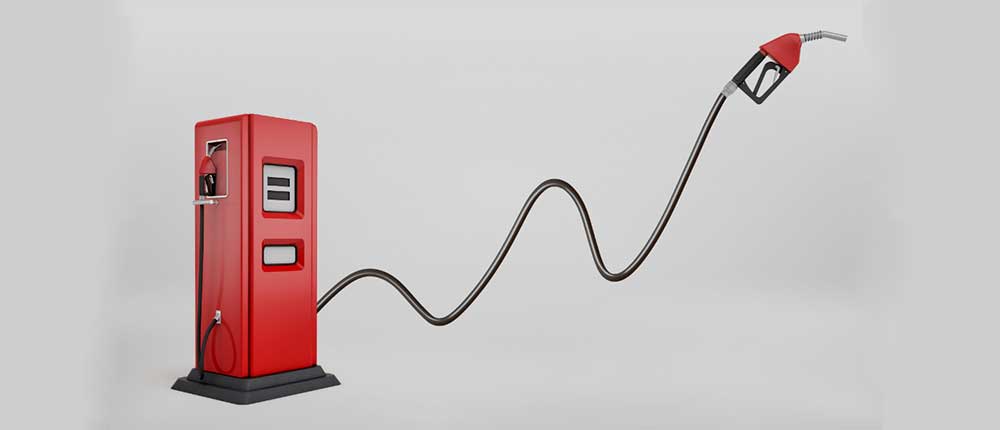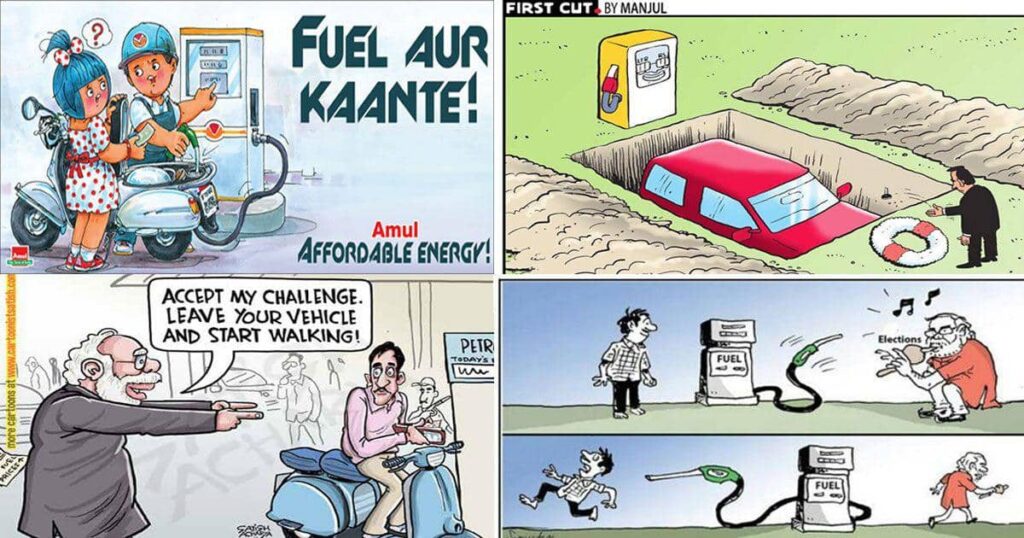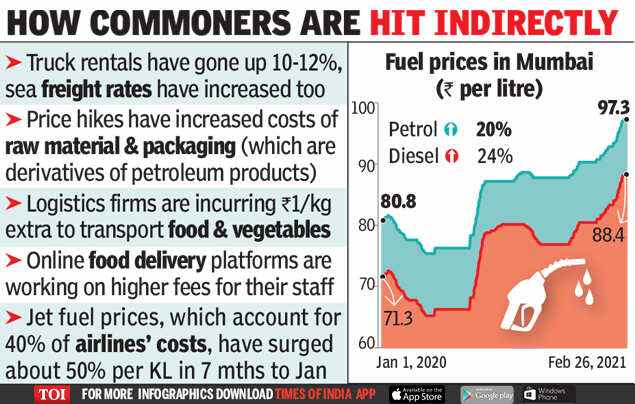The current increase, which comes because of the persistent rise in international oil prices, has lifted pump prices across the country to all-time highs. While gasoline prices are above $100 per litre in all big cities, diesel prices have surpassed that milestone in more than a few others. According to Reuters, the international market is experiencing a record spike in oil prices in October as demand improves following the COVID-19 pandemic downturn. As a result, crude oil prices in India have reached a three-year high. This has had an influence on retail costs of gasoline and diesel, which were already burning a hole in the ordinary man’s purse due to high tax rates.
The overall increase in petrol prices since the government’s decision to hike excise duty to record levels on May 5, 2020, is now 35.98 INR per litre. During this time, diesel prices have risen by 26.58 INR per litre. The government increased excise duties on petrol and diesel to recoup profits that would have otherwise accrued to consumers because of worldwide oil prices plummeting to as low as USD 19 per barrel. While international prices have subsequently recovered to USD 85, excise duty on fuel and diesel has stayed at 32.9 INR and 31.8 per INR litre, respectively.

Oil Minister Hardeep Singh Puri compared calls for excise duty reductions to ‘axing one’s own feet,’ claiming that such levies funded government programs that provided millions of people with free COVID-19 vaccination, meals in the pandemic, and cooking gas too at these crucial times.
He said that the government had completed vaccinating one billion people (against COVID), feeding 90 crores people for a year (during the pandemic), giving three meals per day, and executing the Ujjwala scheme the day before. With just a 32 per gallon excise charge, you may do all of this and more (levied by the central government). Tax revenue is used to improve roads, construct affordable homes for the poor, and pay for other social welfare programs.
He also stated that because he is not the finance minister, it is inappropriate for him to respond and that the 32 per liter that the government collects allows us to deliver all these social programs, including 1 billion immunizations. The rise in gasoline prices has fuelled inflation fears, as diesel is the most common fuel used to transport goods, especially agricultural commodities. The government’s pricing hikes have been criticized by opposition parties, including Congress, who have demanded a tax cut.

Puri had stated that while the federal government imposes a specific excise duty on gasoline and diesel that remains constant regardless of whether oil prices fall to USD 19 per barrel or rise to USD 84 per barrel, state governments impose an ad valorem rate of VAT whose incidence rises with each increase. He said that the price of gasoline was deregulated in 2010, essentially tying it to global markets. The Modi government removed government limits on diesel prices in October 2014. He said that the Kerala High Court had recommended that the inclusion of gasoline and diesel under the Goods and Services Tax (GST) regime be presented to the GST Council.
And “the state governments thought otherwise” when the Council discussed it at its meeting in Lucknow last month, he said, alluding to the panel’s decision not to include fuel and diesel in the GST regime, which would have merged federal excise and state VAT into a single uniform tax.
The Goods and Services Tax does not apply to fuel pricing in the country (GST). The VAT goes to the state government’s revenue, but the excise charge goes to the central government’s wallet. Because the VAT varies from state to state, the price variation is due to VAT and other freight charges. Previously, the government was the sole regulator of gasoline pricing. In 15 days, it was amended once. The government deregulated the price of gasoline and diesel in 2014. It has been amended every day for the past three years, starting in 2017.
OMCs such as Indian Oil Corporation Ltd, Bharat Petroleum Corporation Ltd, and Hindustan Petroleum Corporation make this judgment depending on a variety of variables. However, the PPAC (Petroleum Planning and Analysis Cell) of the Ministry of Petroleum and Natural Gas oversees this. OMCs make these determinations, according to a Lok Sabha response dated March 8, depending on foreign product prices, exchange rates, tax structures, inland freight, and other expenses.
Every day at 6:00 a.m., the price of petrol and diesel is adjusted. According to PPAC, several factors directly influence fuel prices, including crude oil costs, increased demand, taxes, the rupee, and the dollar, and so on. Retail price of petrol = price paid by petrol dealers/distributors to OMCs + excise duty (imposed by the federal government) + dealer’s commission + VAT (imposed by the state government).
After the GST Council meeting, Finance Minister Nirmala Sitharaman revealed that the panel had unanimously resolved to leave petrol and diesel out of the GST regime. The Union Finance Minister chairs the Council, which is made up of delegates from states and UTs. Puri also mentioned the INR 1.34 lakh crores oil bonds issued by the previous Congress-led UPA administration. The bonds are one of the things that BJP leaders have been blaming for the rise in fuel prices, even though he did not relate them to current fuel prices.

The Centre had produced a response earlier this year to address outraged citizens’ worries about price hikes across the country, in which it highlighted that petrol taxes are always changing based on the current government’s policy. These taxes are levied considering the country’s fiscal situation to meet the budgetary needs of the government of India and state governments, as well as to create funds for infrastructure and other developmental projects. Prices fluctuate according to market conditions.
During the previous Congress-led UPA government, petrol, and diesel, as well as cooking gas and kerosene, were sold at subsidised prices. Instead of paying for the subsidies to raise the artificially suppressed retail selling prices in line with the cost that had risen due to international rates crossing USD 100 per barrel, the government issued state-owned fuel retailers oil bonds worth Rs.1.34 lakh crores. These oil bonds, as well as the interest on them, are currently being paid. According to the finance ministry, just 3,500 crores of the 1.34 lakh crores in oil bonds has been paid in principal, with the remaining 1.3 lakh crores due for repayment between this fiscal year and 2025-26.
This fiscal year, the government must return a total of 10,000 crores (2021-22). In 2023-24, another 31,150 crores will be reimbursed, followed by 52,860.17 crores the following year, and 36,913 crores in 2025-26.
The revenue generated by the increase in excise duty, on the other hand, substantially exceeds the amount owed to oil firms. Rameswar Teli, Minister of State for Petroleum and Natural Gas, informed Parliament in July that the Union government’s tax receipts on gasoline and diesel increased by 88 per cent to 3.35 lakh crores in the fiscal year ending March 31 from 1.78 lakh crores the previous year. In the pre-pandemic fiscal year 2018-19, excise collections totalled 2.13 lakh crores.
Written by- Niki Shah
Edited by- Ubai Sura
